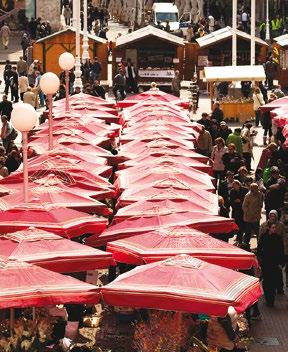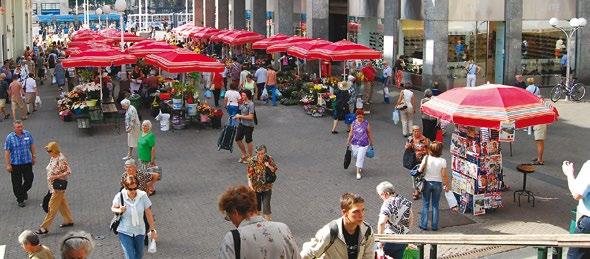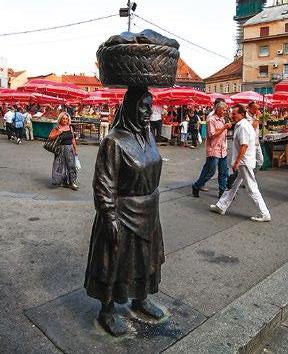
10 minute read
Dolac – An Unparalled Tourist Attraction
Dolac
Photo: J. DUVAL
Advertisement
An Unparalled Tourist Attraction
Dolac – nezaobilazna turistička atrakcija
The Dolac farmers’ market has become an iconic location in Zagreb, visited every week by some 200,000 people. A must destination for Zagreb citizens, it’s known to be one of the cheapest markets; it has also become a tourist and cultural attraction. The popular kumice or farmers’ wives, without whom Zagreb’s markets would not be the same, contribute to Dolac’s popularity. Tržnica Dolac postala je kultno mjesto grada Zagreba, koje tjedno posjeti gotovo 200.000 ljudi. Nezaobilazno odredište Zagrepčana poznato je kao jedna od najjeftinijih tržnica, a postalo je i turistička i kulturna atrakcija. Popularnosti Dolca pridonose i popularne kumice bez kojih su zagrebačke tržnice nezamislive.
Author: MARTINA LOVAKOVIĆ Photographs: INES NOVKOVIĆ, TZGZ
The Dolac farmers’ market has become an iconic location in Zagreb, visited every week by some 200,000 people
Tržnica Dolac postala je kultno mjesto grada Zagreba, koje tjedno posjeti gotovo 200.000 ljudi This year, the Dolac farmers’ market marked its 90th year, yet very few are aware of its turbulent past. There are many records about Dolac farmers’ market but the most interesting fact is that it was built on the site of a – graveyard!
HOW IT ALL STARTED
Following the breakup of the Austro-Hungarian Monarchy in the 1920s and 30s, Zagreb became the main centre of the newly-established Kingdom of Serbs, Croats and Slovenes, and the country’s major financial centre.
The decision was made to move the old market, Harmica, from what is today Ban Jelačić Square. (The name Harmica comes from the Hungarian word harmincz, which translates as one/thirtieth; namely, at the time, the customs duty on imported goods was one/thirtieth of the goods’ value.) The idea was to open a new market in Zagreb, but whenever negotiations were started, they quickly stalled for some reason. The location was the most controversial issue, a topic that was to remain current some 20 years at the start of the 20th century.
After several proposals for the market’s construction and rejected conceptual designs, it was finally decided in 1911 that the Zagreb market would be situated at Dolac. However, World War I had just started, and protests by citizens living at Dolac could not be ignored, so the decision on the new market was only passed in 1925.
The main advocate for the construction of the market at Dolac was the then mayor of Zagreb, architect Vjekoslav Heinzel. A scandal forced Heinzel to resign as mayor and Dr. Stjepan Srkulj was elected to the post. Srkulj continued his predecessor’s efforts to develop the city and the construction of the market was one of his top priorities. Ove godine tržnica Dolac proslavila je 90. godišnjicu postojanja, a malo je onih koji poznaju njezinu turbulentnu povijest. O tržnici Dolac postoje brojni zapisi, a najzanimljiviji je podatak da je izgrađena na – groblju!
Kako je sve počelo
Nakon raspada Austro-Ugarske Monarhije 20-ih i 30-ih godina prošlog stoljeća, Zagreb je postajao glavno središte novonastale Kraljevine Srba, Hrvata i Slovenaca te veliko financijsko središte zemlje.
Donesena je odluka o preseljenju stare tržnice Harmice koja se nalazila na prostoru današnjeg Trga bana Josipa Jelačića. (Ime Harmica dolazi od mađarske riječi harmincz, što znači tridesetica; naime, tada se na uvezenu robu plaćala carina u iznosu tridesetog dijela vrijednosti robe.) Razmišljalo se o otvaranju nove tržnice u Zagrebu, no kad god bi se pregovori pokrenuli, još brže bi se iz nekog razloga obustavili. Najspornije je bilo pitanje o lokaciji tržnice, što je na početku 20. stoljeća bila tema razgovora više od 20 godina.
Nakon nekoliko prijedloga za gradnju tržnice i odbačenih idejnih projekata, 1911. godine konačno je odlučeno da će se zagrebačka tržnica nalaziti na Dolcu. No, počeo je Prvi svjetski rat, a i prosvjedi građana koji su živjeli u kućama na Dolcu nisu se mogli zanemariti, pa je odluka o nacrtu nove tržnice donesena tek 1925.
Glavni zagovaratelj gradnje tržnice na Dolcu bio je tadašnji zagrebački gradonačelnik, arhitekt Vjekoslav Heinzel. Pogođen aferom, morao je odstupiti s mjesta gradonačelnika, a na dužnost je izabran dr. Stjepan Srkulj. Srkulj se nastavio zalagati za razvoj grada, koji je pokrenuo njegov prethodnik, a kao jedan od glavnih prioriteta isticao je upravo izgradnju tržnice.


Work began in 1927 but was interrupted again two years later. Namely, King Aleksandar introduced the 6 January Dictatorship which annulled all the existing bodies of authority in the Kingdom of Serbs, Croats and Slovenes.

Dr. Srkulj, however, stood his ground. He demanded from King Aleksandar that he allow the construction to continue and to keep his mayoral post, which the king soon agreed to. That same year, on 9 March 1929, Mayor Srkulj convened a session of the assembly with only one item on the agenda, the completion of the market.
On 1 September 1930, at precisely eight o’clock in the morning, proud Mayor Stjepan Srkulj finally inaugurated the new market at Dolac which over the next 90 years would become Zagreb’s most popular market and an iconic feature of the city.
A MARKET BUILT ON THE SITE OF A GRAVEYARD
Today, very few people are aware that as recently as the beginning of the 20th century, the site of today’s market was a small, densely populated neighbourhood with mainly hovels. The construction of the market required the settlement to be pulled down. In the course of the construction work and excavation, an old graveyard was discovered alongside St. Mary’s Church.
The work raised criticism from almost all of Zagreb society. Numerous writers, historians and citizens discussed the issue in a negative context, and the decision to build a market on the site of a medieval settlement remained controversial for a long time.
Nevertheless, the champions of modernisation were relentless and the project was continued. Pod Zidom Street is the only thing that remains of the old settlement today.
FARMER’S WIFE BARICA
The farmers’ wives make Dolac recognizable. They are friendly sellers who come to Dolac to sell their produce from all over Croatia and each speaks her own dialect which is sometimes hard to understand. However, they share a common conviviality as they try to convince you to buy their fruit and vegetables or try their homemade cheese. Radovi su započeli 1927., a nakon dvije godine ponovno su prekinuti. Naime, kralj Aleksandar je uveo šestosiječanjsku diktaturu zbog koje prestaju postojati sva dotadašnja tijela vlasti u Kraljevini SHS.
No, dr. Srkulj je bio neumoljiv. Zahtijevao je od kralja Aleksandra da dopusti nastavak radova te da on zadrži svoje mjesto gradonačelnika, na što je kralj ubrzo i pristao. Te iste godine, 9. ožujka 1929., gradonačelnik Srkulj sazvao je novu sjednicu skupštine sa samo jednom točkom dnevnog reda o dovršenju gradske tržnice.
Ponosni gradonačelnik Stjepan Srkulj 1. rujna 1930. točno u osam sati konačno je otvorio novu tržnicu Dolac koja je tijekom sljedećih 90 godina postala najpopularniji zagrebački plac i kultno mjesto grada Zagreba.
Tržnica izgrađena na groblju
Malotko danas zna da se još i početkom 20. stoljeća na mjestu današnje tržnice nalazilo gusto naseljeno malo naselje s uglavnom siromašnim kućama. A radi izgradnje tržnice, taj dio grada morao je biti srušen. Tijekom građevinskih radova i iskapanja zemlje otkriveno je staro groblje koje se nalazilo uza crkvu sv. Marije.
Radovi su tada izazvali kritiku gotovo svih članova zagrebačkoga društva. O tome su u negativnom kontekstu govorili brojni književnici, povjesničari i građani, a odluka o izgradnji tržnice na mjestu srednjovjekovnog naselja dugo je bila kontroverzna.
Ipak, zagovornici modernizacije bili su ustrajni, pa je projekt nastavljen, a danas je od starog naselja ostala samo ulica Pod zidom.
Kumica Barica
Dolac je prepoznatljiv po svojim kumicama, simpatičnim prodavačicama koje oduvijek na Dolac dolaze prodavati svoje proizvode iz različitih dijelova Hrvatske, a svaka govori svojim dijalektom koji je ponekad teško razumljiv. No, svima je zajedničko da su pune topline, dok vas uvjeravaju da kupite upravo njihovo voće ili povrće ili kušate njihov domaći sir.

The statue of the farmer’s wife with a basket on top of her head was modelled after Đurđica Janušić from Odra, and the citizens of Zagreb n icknamed it Barica.

Kip kumice s košarom na glavi napravljen je prema liku Đurđice Janušić iz Odre, a Zagrepčani su mu nadjenuli ime Barica
That is why in 2006, a statue entitled “Farmer’s Wife” was erected to the left at the top of the stairs that lead to Dolac. The sculptor is Stjepan Gračan, who also created the statue of Marija Jurić Zagorka in Tkalčićeva Street.
The statue of the farmer’s wife with a basket on top of her head was modelled after Đurđica Janušić from Odra, and the citizens of Zagreb nicknamed it Barica.
Đurđica first came to the market to sell her homegrown garlic in 1964 when she was just seventeen. Today, everyone knows her, from shoppers, tram drivers to Mayor Milan Bandić. She has met many famous personalities, among them the former prime minister of the United Kingdom, Margaret Thatcher. Her stall has been in the same place for over 55 years, and she’s still as passionate about her work as she was in the beginning. Her son drives her to Dolac every morning and she returns home by bus.
DOLAC TODAY
The best way to get to Dolac is to cross Ban Josip Jelačić Square from where steps lead up to the market. To get to the stairs, you’ll cross Splavnica – a small street where seedlings and flowers are sold. The market consists of an indoor and an open-air area. Fruits and vegetables are sold in the open-air area and fish mongers and butchers are in the indoor area.
Today, Dolac is a well-known tourist attraction visited by tourists from all over the world. The market is not just for Zagreb citizens, but also for the English, Chinese, Germans, Italians and many others who know that shopping at Dolac is part of the tourist experience in Zagreb. So, when you find yourself in Zagreb, don’t fail to visit the place where you’ll feel the pulse of the city, buy fresh fruit and vegetables while haggling with the farmers’ wives, lose yourself in the hubbub and taste some local delicacies. Photo: M. VRDOLJAK
Stoga je 2006. godine na vrhu stepenica koje vode na Dolac s lijeve strane postavljen spomenik „Kumica“. Riječ je o radu kipara Stjepana Gračana koji je i autor kipa Marije Jurić Zagorke u Tkalčićevoj ulici.
Kip kumice s košarom na glavi napravljen je prema liku Đurđice Janušić iz Odre, a Zagrepčani su mu nadjenuli ime Barica.
Kumica Đurđica prvi je put na plac donijela svoj domaći češnjak još 1964., kad je imala samo 17 godina. Danas je poznaju svi, od kupaca i vozača ZET-a do gradonačelnika Milana Bandića. Upoznala je brojne poznate osobe, među kojima i bivšu premijerku Ujedinjenog Kraljevstva Margaret Tacher. Njezin se štand nalazi na istome mjestu već više od 55 godina, a svoj posao obavlja s jednakom strašću i veseljem kao nekad. Svako jutro na Dolac je automobilom vozi sin, a kući se vraća autobusom.
Dolac danas
Do Dolca se najlakše dolazi preko Trga bana Josipa Jelačića s kojeg vode stepenice do tržnice. Do stepenica ćete proći Splavnicom – uličicom na kojoj se prodaju sadnice biljaka i cvijeće. Tržnica se sastoji od otvorenog i zatvorenog dijela. Na otvorenom dijelu nalaze se štandovi na kojima se prodaje voće i povrće, a u zatvorenom dijelu su ribarnica i mesnice.
Danas je Dolac poznata turistička atrakcija koju posjećuju turisti iz cijelog svijeta. Taj plac nije rezerviran samo za Zagrepčane, već i za Engleze, Kineze, Nijemce, Talijane i mnoge druge koji znaju da je kupnja na Dolcu dio turističkog doživljaja Zagreba. Stoga, kad se zateknete u Zagrebu, ne propustite posjetiti mjesto na kojem ćete osjetiti kako grad diše, kupiti svježe voće i povrće uz čaroliju cjenkanja s kumicama, izgubiti se u žamoru ljudi i kušati neke autohtone zagrebačke delicije.







